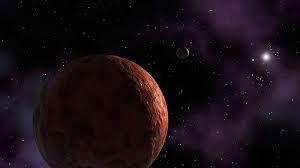The discovery of a new ‘dwarf planet’ expands our view of the solar system
The ‘dwarf planet’ Sedna, is seen in an artist’s rendering released by NASA on March 26, 2014. The bright object in the background is the Sun.
Astronomers report they have spotted a 'dwarf planet' way out on the edge of the solar system. It’s the second one of its kind found in this region of space and it may redefine our understanding of the solar system.
The first 'dwarf planet' found in this unexpected location, now known as Sedna, was discovered in 2003, and at the time was thought to be an anomaly. It took 10 years to find a second one.
The new 'dwarf planet,' called 2012 VP113 (nicknamed “Biden”), was discovered by Chad Trujillo, an astronomer at the Gemini Observatory, and Scott Sheppard of the Carnegie Institution for Science in Washington, DC. They first reported their findings in the journal Nature. The finding has excited astronomers, as it makes it more likely Sedna isn’t just some isolated fluke.
“It goes to show that there’s something we don’t know about our solar system, and it’s something important,” says Trujillo. “We’re starting to get a taste of what’s out beyond what we consider the edge.”
The term 'dwarf planet' was adopted in 2006 after Sedna's discovery. Because Sedna is larger and further out in space than Pluto, also a 'dwarf planet' — in an area of the solar system called the “inner Oort Cloud" — astonomers established new guidelines for classifying a celestial body as a planet. (They also decreed that the term 'dwarf planet' must always be placed within single quote marks.)
At the general assembly of the International Astronomical Union, scientists agreed that for a celestial body to qualify as a planet:
- it must be in orbit around the Sun
- it must be large enough that it takes on a nearly round shape
- it must have cleared its orbit of other objects
Neither Sedna nor Pluto met all three criteria, so scientists placed both objects in the new 'dwarf planet' category. Trujillo was one of the astronomers who discovered Sedna in 2003. At the time, he says, scientists were excited because they hadn’t expected to find an object like it in that region of space. 2012 VP113 is located in the same region, but even farther out, and its orbit is something of a puzzle.
Sedna’s closest approach to the Sun (or “perihelion”) is almost 76 Astronomical Units, twice as far away as Neptune (one astronomical unit is 93 million miles, the distance between the Earth and the Sun). At the time, Trujillo says, 76 AU was the largest perihelion — or “furthest closest approach” — ever known.
“Biden's" closest approach is 80 astronomical units. And whereas Sedna travels as far as 1,000 AU from the Sun, Biden’s outer orbit is 452 AU. This suggests that "Biden" is more closely bound by the Sun’s gravity, which astronomers are currently at a loss to explain.
Sedna and “Biden” are significant finds, Trujillo says, because “we don't really know how they got there. … We know that the objects didn’t form out there by themselves, because it's really hard to make a planet or a 'dwarf planet' far away from the sun. Things have to be on a quiet, circular orbit, closer to the sun to form planets. So we don't think Sedna or VP113 formed out there. So then the question is, How did they get there?”
The hypotheses astronomers are working with are interesting, Trujillo says, because they examine events that took place very early in the formation of the solar system.
“The sun, we think, formed in a star cluster with a bunch of other stars,” Trujillo explains, “It’s possible that billions of years ago, when the sun was forming, another one of the sun’s “siblings” came close to it and might have actually pulled material out from where the planets are today out into these strange orbits.”
Another possibility astronomers have considered is that “rogue planets” may have been in the solar system where the planets are today, but were “ejected out” at some point in the past, perhaps by Jupiter. As these objects were flung out of their orbits, they may have carried material with them out into the “no man's land” where Sedna and Biden are located.
Trujillo says he and other astronomers are actively looking for more inner Oort Cloud objects. They think there are more out there. In fact, there may be a lot more out there. From some simple simulations they’ve run, Trujillo says, they estimate there could be as many as a hundred billion inner Oort Cloud objects similar to Sedna and Biden.
This story is based on an interview by our partner Science Friday, a weekly radio show and website covering science, technology and other cool stuff.
